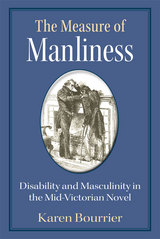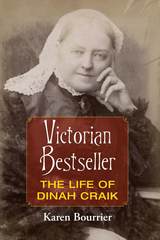2 books about Bourrier, Karen

The Measure of Manliness
Disability and Masculinity in the Mid-Victorian Novel
Karen Bourrier
University of Michigan Press, 2015
The Measure of Manliness is among the first books to focus on representations of disability in Victorian literature, showing that far from being marginalized or pathologized, disability was central to the narrative form of the mid-century novel. Mid-Victorian novels evidenced a proliferation of male characters with disabilities, a phenomenon that author Karen Bourrier sees as a response to the rise of a new Victorian culture of industry and vitality, and its corollary emphasis on a hardy, active manhood. The figure of the voluble, weak man was a necessary narrative complement to the silent, strong man. The disabled male embodied traditionally feminine virtues, softening the taciturn strong man, and eliciting emotional depths from his seemingly coarse muscular frame. Yet, the weak man was able to follow the strong man where female characters could not, to all-male arenas such as the warehouse and the public school.
The analysis yokes together historical and narrative concerns, showing how developments in nineteenth-century masculinity led to a formal innovation in literature: the focalization or narration of the novel through the perspective of a weak or disabled man. The Measure of Manliness charts new territory in showing how feeling and loquacious bodies were increasingly seen as sick bodies throughout the nineteenth century. The book will appeal to those interested in disability studies, gender and masculinity studies, the theorization of sympathy and affect, the recovery of women’s writing and popular fiction, the history of medicine and technology, and queer theory.
[more]

Victorian Bestseller
The Life of Dinah Craik
Karen Bourrier
University of Michigan Press, 2019
When novelist Dinah Craik (1826–87) died, expressions of grief came from Lord Alfred Tennyson, Matthew Arnold, Robert Browning, T.H. Huxley, and James Russell Lowell, among others, and even Queen Victoria picked up her pen to offer her consolation to the widower. Despite Craik’s enormous popularity throughout a literary career that spanned forty years, she is now all but forgotten. Yet, in an otherwise respectable life bookended by scandal, this was precisely the way that she wanted it.
Victorian Bestseller is the first book to relate the story of Dinah Craik’s remarkable life. Combining extensive archival work with theoretical work in disability studies and the professionalization of women’s authorship, Karen Bourrier engagingly traces the contours of this author’s life. Craik, who wrote extensively about disability in her work, was no stranger to it in her personal and professional life, marked by experiences of mental and physical disability, and the ebb and flow of health. Following scholarship in the ethics of care and disability studies, the book posits Craik as an interdependent subject, placing her within a network of writers, publishers, editors and artists, friends, and family members. Victorian Bestseller also traces the conditions in the material history of the book that allowed Victorian women writers’ careers to flourish. In doing so, the biography connects corporeality, gender, and the material history of the book to the professionalization of Victorian women’s authorship.
Victorian Bestseller is the first book to relate the story of Dinah Craik’s remarkable life. Combining extensive archival work with theoretical work in disability studies and the professionalization of women’s authorship, Karen Bourrier engagingly traces the contours of this author’s life. Craik, who wrote extensively about disability in her work, was no stranger to it in her personal and professional life, marked by experiences of mental and physical disability, and the ebb and flow of health. Following scholarship in the ethics of care and disability studies, the book posits Craik as an interdependent subject, placing her within a network of writers, publishers, editors and artists, friends, and family members. Victorian Bestseller also traces the conditions in the material history of the book that allowed Victorian women writers’ careers to flourish. In doing so, the biography connects corporeality, gender, and the material history of the book to the professionalization of Victorian women’s authorship.
[more]
READERS
Browse our collection.
PUBLISHERS
See BiblioVault's publisher services.
STUDENT SERVICES
Files for college accessibility offices.
UChicago Accessibility Resources
home | accessibility | search | about | contact us
BiblioVault ® 2001 - 2024
The University of Chicago Press









